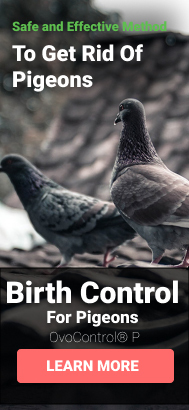Learn where to use OvoControl®.
OvoControl® — birth control for pigeons — is a proven, safe and effective solution for controlling the pigeon population when physical deterrents aren’t feasible or cost effective.
EFFECTIVE AND SAFE PIGEON CONTROL
Do you have a pigeon infestation? Unfortunately, successfully controlling pigeons is not an overnight process and there are no magic bullets. With a wide range of pigeon control solutions available on the market today, it can be difficult to determine which ones are truly effective and how they’ll work under your unique set of circumstances or site characteristics.
Our product works where physical deterrents or poisoning birds are not feasible or cost effective.
Chemical Plants
Oil Refineries
Steel Mills
Manufacturing Facilities
Power Utilities
Campuses
Dense Urban Areas
Large Cities
Prisons
Small Towns
Hospitals
Food Processing Facilities
Shopping Centers
Casinos and Hotels
Condominiums
HOW DO PIGEONS CAUSE SO MUCH DAMAGE?
Is it really possible that pigeons cause that much of a problem? Actually, the issue is not the pigeons but rather what they leave behind….the debris, nesting material and worst of all, a mixture of urine and feces. A pigeon consumes roughly 30 grams of dry matter and 30 ml of water, daily. Do the math and a flock of just 100 pigeons can deposit up to 4,800 pounds of waste, annually. That represents a lot of poop and it has to accumulate someplace.
Concerns from industrial customers typically fall into three categories.
SLIP AND FALL HAZARDS
A major issue for large industrial facilities that necessarily have a focus on safety are slip and fall hazards. Not only does pigeon feces result in slippery surfaces, nesting pigeons can be spooked when a worker inadvertently disturbs the pigeons in their nesting areas. That type of incident can result in a fall or “near miss” situation, a scenario that should be avoided.
INCREASED MAINTENANCE
Under industrial scenarios, pigeon poop and debris requires someone to clean it up. This can be as easy as the closest dust pan, but when feces gets into sensitive equipment and product, it can represent an economic hardship. Furthermore, the combination of pigeon feces and urine is highly corrosive and under the right set of conditions will even corrode steel and concrete.
HEALTH RISKS
Some sources will describe the health risks from pigeons as acute. Since they are ubiquitous in everyday life, most readers do not take these opinions seriously. Nevertheless, the WHO recently published the guide, “Public Health Significance of Urban Pests“. In it, the authors identify 60+ different diseases associated with pest birds, most prominently pigeons. In addition to vectors for bacteria (causative agents for histoplasmosis and cryptoococcosis), pigeons are associated with viruses, endo and ectoparasites. The health risks should not be underestimated.
Perhaps more critical are the health risks which pigeon feces represent when they come in contact with food or feed. Contamination of food beginning at the farm and ending in the kitchen represents a very serious food safety risk that should not be overlooked.
For most facilities and plants, the “pain” of pigeons is expressed as a function of these three concerns. Depending on the facility, one or the other concerns may represent more or less of a hazard.
WHY RELOCATING PIGEONS IS NOT AN OPTION
In an attempt to find a humane solution, many pigeon impacted sites and service providers will resort to relocating pigeons. Once trapped, the pigeons are taken miles from their original location and let fly again. Unfortunately, even when transported hundreds of miles, most will beat the truck back.
Like many birds, pigeons have a remarkable homing instinct and most will return to the identical location where they originated. Trapping and relocating pigeons has no benefit in an abatement program. Unfortunately, once trapped, the pigeons must be euthanized.
While trapping and euthanizing birds may give the impression of effective abatement, the impact on the population is fleeting. Pigeons breed rapidly – up to six times, annually – with two eggs per clutch. Just five mating pairs can produce up to 400 pigeons in two years.
Therefore, unless all are trapped, the remaining birds will quickly fill the vacuum. If all are trapped, unless there are physical changes to prevent it, another flock will move into the attractive habitat. In fact, all attempts to “increase mortality” by trapping, shooting or poisoning suffer from the same limitation.
Pigeon Control Strategies
At larger, pigeon impacted facilities where physical exclusion is impractical or cost prohibitive, reducing reproduction with contraceptive control is far more effective than increasing mortality. See the graphic below for alternative strategies.
While there are many different products, there are just a handful of pigeon control strategies. The tool(s) selected is most often a function of site characteristics and management objectives.
In most cases, the strategies can be combined for the best possible outcome and solution for a given site. For example, exclusion can be combined with abatement when both strategies are required to resolve the pigeon infestation.
Since they breed so rapidly, increasing mortality alone does not have a lasting effect or provide a long-term solution for the site. That's where Ovocontrol's pigeon control program comes in.
OvoControl® fits in the abatement category by reducing reproduction. This strategy prevents birds from simply refilling the vacuum created from increasing mortality. The population declines naturally, though attrition, with a small remaining flock to keep others from moving in.




